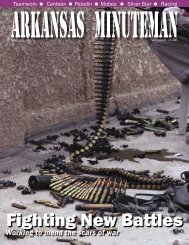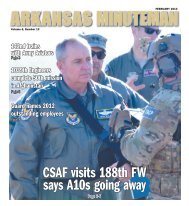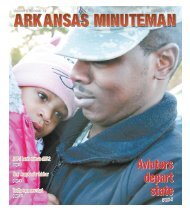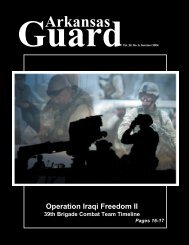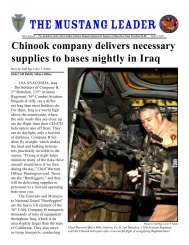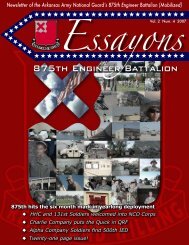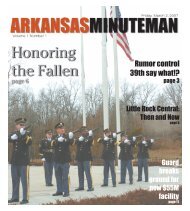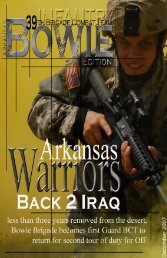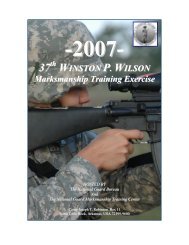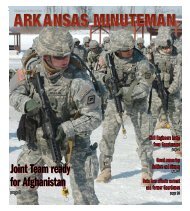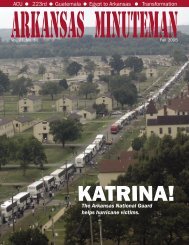The Bowie Edition October 29, 2004 - Arkansas National Guard
The Bowie Edition October 29, 2004 - Arkansas National Guard
The Bowie Edition October 29, 2004 - Arkansas National Guard
You also want an ePaper? Increase the reach of your titles
YUMPU automatically turns print PDFs into web optimized ePapers that Google loves.
On the cover…<br />
Inside This <strong>Edition</strong><br />
<strong>The</strong> <strong>Bowie</strong> <strong>Edition</strong> <strong>October</strong> <strong>29</strong>, <strong>2004</strong><br />
Staff Sgt. William Ensey, a Task Force 1-206 Soldier from Alma, Ark., prepares to move up the<br />
stairs of an Iraqi home during a cordon and search operation on <strong>October</strong> 27 th , in Taji, Iraq. Ensey<br />
continues to serve in support of Operation Iraqi Freedom II, while nearly 400 39 th Brigade Combat<br />
Team Soldiers prepare to return home. <strong>The</strong> departing Soldiers are nearing the completion of two<br />
years of deployed service within the past five, due to an earlier deployment to Egypt. <strong>The</strong> Soldiers,<br />
having performed their duty when called upon, are now returning home based on the Department of<br />
Defense policy, which states <strong>Guard</strong>smen can not exceed two years of involuntary deployed service<br />
within a five-year period. (Photo by 1 st Lt. Chris J. Heathscott, 39 th Brigade Public Affairs Office.)<br />
Baghdad Island: Amusing Memories Revived<br />
Task Force 3-153 gets “Big on Baghdad” with a restoration project for Baghdad’s version of<br />
Disneyland …………………………………………………..……………………………………..…<br />
Continuing the Push Towards Peace<br />
Despite the continued threat of violence by insurgent forces, 1 st Lt. Isaac Shields, of Task Force 3-<br />
153 says he refuses to give up helping the Iraqi people……...……………………………………….<br />
This One’s for Sarah…Tracking Down a Killer<br />
Soldiers of A Company, 3 rd Battalion 153 rd Infantry seek out justice for the murder of Sahara Latiff,<br />
a beloved interpreter better known to them as ‘Sarah’.…………………………… …………………<br />
Helping the Agricultural Industry ‘Grow’ in Taji<br />
Operation Amber Waves kicks off with a delivery of 156 tons of wheat seed for distribution to<br />
farmers in the Taji area of Iraq.………………………………………………………………………… 8<br />
3<br />
4<br />
6<br />
Timely Response Saves Lives<br />
An early morning mortar attack on an Iraqi <strong>National</strong> <strong>Guard</strong> Patrol Base brings heroes to light as<br />
Soldiers from Task Force 2-7 and Task Force 2-162 saves several lives with quick medical<br />
response…………………………………………………….……………………………………… 10<br />
American Medic Disregards Own Life to Save Iraqi Soldiers<br />
Sgt. Max Picco, a Task Force 2-7 Soldier, is recognized for his heroism and quick response<br />
during a mortar attack on an Iraqi <strong>National</strong> <strong>Guard</strong> Patrol Base………….………………………...<br />
Handheld Aircraft Provides Birdseye View<br />
<strong>The</strong> 239 th and 6<strong>29</strong> th Military Intelligence<br />
Companies are working together to provide the<br />
units on the ground with an eye in the sky……..<br />
‘Charlie Med’ Soldiers Awarded CMB<br />
Forty Soldiers of the 39 th Support Battalion’s<br />
Company C are honored for their efforts during<br />
a deadly mortar attack on April 24 th ,<br />
<strong>2004</strong>…………………………………………....<br />
Soldiers Pay Final Tribute to Fellow Rifleman, Cook<br />
Spc. David Wayne Johnson, a Task Force 2-162 Soldier, is remembered<br />
at a memorial service in his honor………………………………………..<br />
12<br />
14<br />
15<br />
39 th Brigade Commander<br />
Brig. Gen. Ron Chastain<br />
Command Sergeant Major<br />
Command Sgt. Maj. Larry Isbell<br />
Public Affairs Officer<br />
1 st Lt. Chris J. Heathscott<br />
Staff Writers<br />
Staff Sgt. Rebekah-mae N. Bruns<br />
Cpl. Benjamin Cossel<br />
11<br />
<strong>The</strong> <strong>Bowie</strong> <strong>Edition</strong> is a publication of the 39 th<br />
Brigade Public Affairs Office. This family<br />
support group newsletter contains official<br />
information and complies with the provisions of<br />
AR 360-1. Questions or concerns can be<br />
directed to the editor at<br />
christopher.heathscott@us.army.mil
<strong>The</strong> <strong>Bowie</strong> <strong>Edition</strong> <strong>October</strong> <strong>29</strong>, <strong>2004</strong><br />
Baghdad Island: Amusing<br />
Memories Revived<br />
By Sgt. Dan Purcell<br />
122 nd Mobile Public Affairs Detachment<br />
It’s not Disneyland, but in it’s heyday it<br />
could boast no other rival in Iraq—<br />
Baghdad Island, once the premiere<br />
amusement park in Iraq, is being revived.<br />
<strong>The</strong> foundation for the island was laid in<br />
1979 and completed in 1982. It<br />
encompasses two million square meters<br />
(approximately three kilometers long by<br />
one kilometer at it’s widest point) and<br />
daily attendance averaged from five to six<br />
thousand people, but during holidays and<br />
special days could peak around 50,000 to<br />
100,000 said Nasser Murad, Baghdad<br />
Island project restoration director.<br />
“<strong>The</strong> park was open until the beginning<br />
of the last war in 2003. Prior to that it was<br />
the largest theme park in Baghdad and the<br />
whole of Iraq…and conceivably, even the<br />
Middle East,” Murad said.<br />
Since its closure, the island has fallen<br />
into a general state of disrepair, much of<br />
which was caused by looting.<br />
“Our main goal now is to restore the<br />
island and open it to the people again,”<br />
explained Murad. “To achieve this goal,<br />
we are approaching it in two ways. First,<br />
we are asking for help from the [Multi-<br />
<strong>National</strong> Forces] through their civil affairs<br />
teams. Secondly, we are receiving<br />
assistance from the Ministry of Tourism<br />
and Culture, which is in charge of this<br />
project.”<br />
“We got started here when we saw them<br />
working on a project to bring the island<br />
back,” said Maj. Charles Anderson, of the<br />
478 th Civil Affairs Battalion, which is<br />
attached to the 39 th Brigade Combat<br />
Team’s 3 rd Battalion, 153 rd Infantry. “We<br />
met with the director here, and one of the<br />
key things he did was show us some videos<br />
of the park from the past. <strong>The</strong>y really<br />
opened our eyes to what this park is all<br />
about…the crowds of people, the<br />
attractions and landscaped gardens.”<br />
Due to the width and breath of the<br />
restoration project, the short-term plan is to<br />
have a partial opening to the public within<br />
the next year so that people will have a<br />
place to go and enjoy themselves. <strong>The</strong><br />
revenue will help generate funding to<br />
complete the restoration, one phase at a<br />
time.<br />
“This isn’t just a place for families, but a<br />
place for young men and women to come<br />
and hangout,” one Iraqi said. “It’s a place for<br />
school field trips. <strong>The</strong> people of Iraq have<br />
a history of coming to the island, many even<br />
got married here.”<br />
According to Murad, in addition to<br />
receiving help from the Multi-<strong>National</strong> Forces<br />
(MNF), the Ministry of Tourism and Culture<br />
has authorized funding for five new projects<br />
at the park.<br />
“<strong>The</strong> more we commit to do, the more the<br />
ministry is willing to help,” explained<br />
Anderson. “For example, we just completed<br />
the children’s theater and the ministry is<br />
going to install a projector system…it’s like a<br />
partnership, matching effort for effort.<br />
Neither of us has the funding for the entire<br />
project because it’s very expensive.”<br />
<strong>The</strong> problem, as Anderson sees it is that<br />
with most money being diverted to address<br />
infrastructure repairs in Baghdad, the island<br />
project has become a work in progress.<br />
“It’s a fantasy to think that we can do this<br />
project all at one time like we want to. So we<br />
are doing our infrastructure, roads, schools<br />
and these projects here altogether,” Anderson<br />
cited. “That’s why getting this park going<br />
will take time, because we have to do it in<br />
phases.”<br />
Nasser Murad,<br />
the Baghdad<br />
Island project<br />
restoration<br />
director and Maj.<br />
Charles<br />
Anderson, a team<br />
leader with the<br />
478th Civil<br />
Affairs Battalion,<br />
discuss ongoing<br />
renovations at<br />
Baghdad Island.<br />
(Photo by Sgt.<br />
Dan Purcell,<br />
122nd Mobile<br />
Public Affairs<br />
Detachment)<br />
3<br />
In addition to the financial help received from<br />
the MNF and the ministry, public support has<br />
also been forthcoming.<br />
“<strong>The</strong> public has been generally<br />
supportive. We have volunteers tearing down<br />
walls, put up by the [MNF] when they<br />
temporarily occupied this area after the war, and<br />
hauling the material away,” Murad said.<br />
When the park, which is located along the<br />
banks of the Tigris River, is completed it will<br />
sport the most modern rides found world wide,<br />
a hotel, and a lake with boats to name a few of<br />
the attractions.<br />
“Currently, we have completed a sewage<br />
system project, installed a children’s theater,<br />
and are working on an athletic center. We are<br />
also about to start putting in a swimming pool,”<br />
Anderson said, detailing some of the ongoing<br />
projects. “<strong>The</strong>re are many more projects in the<br />
planning because it’s a huge facility, but this is<br />
a good start in the right direction to bring this<br />
island back to its original state.”<br />
“It’s been a team project all the way, but it’s<br />
been a personal pet of mine,” added Sgt. Jason<br />
Jones, of the 489 th Civil Affairs Battalion. “I<br />
figure if you can get people off the streets and<br />
give them something to do, then they’re less<br />
likely to harm someone.”
<strong>The</strong> <strong>Bowie</strong> <strong>Edition</strong><br />
Continuing the Push Towards<br />
Medical Assistance Missions Persevere Despite Challenges<br />
by 1 st Lt. Chris J. Heathscott, 39 th Brigade Combat Team Public Affairs Office<br />
Returning from an medical assistance<br />
visit at the Al Saab Clinic in Baghdad, a<br />
convoy of 39 th Brigade Soldiers and<br />
medical personnel pulled up to a ‘parking<br />
lot’ on the highway. Nearly locked in<br />
traffic, this mission with the intent to help<br />
the Iraqi people was now at a greater risk<br />
of attack by insurgent forces.<br />
“Every time we go out there and try to<br />
help, obviously, the threat’s there,” said 1 st<br />
Lt. Isaac Shields, medical platoon leader<br />
for the 39 th ’s 3 rd Battalion, 153 rd Infantry.<br />
“We have encountered [Improvised<br />
Explosive Devices], we’ve stumbled<br />
across caches…it happens, but the key to<br />
success is we keep going.”<br />
<strong>The</strong> line of vehicles negotiated the curb<br />
on the side of the road and continued past<br />
the traffic when they encountered the<br />
problem ahead. Some Iraqi citizens were<br />
trying to free their minivan, which had<br />
bottomed out when their left front tire hit<br />
a drop off on the side of the road.<br />
<strong>The</strong> convoy came to a halt, the heavy up<br />
armored doors swung open and out step<br />
two American Soldiers to assist. Now<br />
with all four tires on the ground, Spc.<br />
Terry Kittrell Jr., of McCrory, Ark., and<br />
Sgt. David Johnson, of Colt, Ark.,<br />
returned to their armored shelter, while<br />
exchanging waves with the Iraqis they had<br />
helped.<br />
Back to the mission at hand…returning<br />
to Forward Operation Base Solidarity<br />
(formerly labeled FOB ‘Gunslinger’),<br />
wrapping up a two hour visit to the Clinic.<br />
<strong>The</strong> good Samaritan deed on the highway<br />
was a fitting end the mission that was<br />
focused on helping the Iraqi people,<br />
despite the potential threats. Despite the<br />
risk involved, the missions to help the<br />
Iraqi people overcome continue.<br />
“<strong>The</strong> reason we came here today is part<br />
of what we call our ‘medical journal<br />
project,’” said Shields. “During this<br />
project, American physicians and dentists<br />
have donated books out of their homes to<br />
give to the Iraqi physicians and dentists.”<br />
Shields, who is an <strong>Arkansas</strong> <strong>National</strong><br />
<strong>Guard</strong>sman from Starkville, Miss., said<br />
assessments of the local clinics appeared<br />
they were ‘behind the times’ on medical<br />
technology as we know it in the United<br />
States. Working on his Doctorate in<br />
Clinical Psychology at the University of<br />
Tulsa, Shields decided to ask his wife to<br />
ship his old medical textbooks, so he<br />
could give them to the clinic.<br />
Shields said, “<strong>The</strong> first clinic was so<br />
grateful for it, I emailed some of my<br />
buddies and said ‘hey guys I got a good<br />
response for this. Can you send me some<br />
of your old textbooks?’”<br />
As a result, his buddies responded and<br />
passed along the message. <strong>The</strong> initial<br />
request awarded Shields with books from<br />
his friends, as well as from several other<br />
individuals, medical schools and hospitals.<br />
“So every time we go out to a clinic, we<br />
try to bring more books out there,” said<br />
Shields. “We’ve received several<br />
thousands books.”<br />
“<strong>The</strong> greatest thing about this project is<br />
that it’s the American people doing it,” he<br />
said. “It’s not a government organization.<br />
<strong>The</strong>se are American citizens that are<br />
taking stuff off of their shelves and<br />
sending it to the Iraqi people.”<br />
<strong>The</strong> mission for this day was more than a<br />
book drop however. Two military doctors<br />
participated in the operation in an attempt<br />
to mentor the Iraqi doctors and dentists,<br />
evaluate their methods, and help them in<br />
any way possible. Col. Jim Orsini, of<br />
Little Rock, and COL Jim Green, of Fort<br />
Smith, Ark., both accompanied the<br />
convoy to the Al Saab Clinic in order to<br />
provide their professional expertise. <strong>The</strong><br />
men, who serve in the 39 th as the Brigade<br />
Dentist and the 3 rd Battalion Physician<br />
respectively, both perform the same roles<br />
in their civilian occupations.<br />
As the men visited with their<br />
counterparts inside the clinic, a call came<br />
over the radio, warning that an Improvised<br />
Explosive Device was located nearby and<br />
was going to be blown in place.<br />
<strong>The</strong> bomb would now cause little<br />
damage, yet the unnerving thought of a<br />
potential life-threatening explosion<br />
created a tense moment for the Iraqi<br />
physician who was first told of the<br />
finding.<br />
As the man was ensured everything was<br />
under control, he took on the challenging<br />
task of informing his patients of the<br />
upcoming explosion.<br />
“Its unfortunate and disappointing, but as<br />
long as Iraqis need help were going to<br />
come here and help,” said Shields. “I’m<br />
not going to give up on them, it doesn’t<br />
matter what the threat level is. We came<br />
here to help them build a new strong<br />
government and until that happens were<br />
going to keep doing it.”
<strong>October</strong> <strong>29</strong>, <strong>2004</strong><br />
Peace<br />
Background – An Iraqi<br />
child sits in a pile of trash,<br />
looking through a book he<br />
found along the road near<br />
the Al Saab Clinic in<br />
Baghdad. Scenes like these<br />
often inspire Soldiers to<br />
continue with the mission to<br />
help the Iraqi people despite<br />
the challenges. Left –<br />
Spc. Terry Kittrell Jr., of<br />
McCrory, and Sgt. David<br />
Johnson, of Colt, Ark., help an Iraqi man move his car from<br />
blocking traffic on the highway. Clockwise from top right<br />
– An Iraqi child shows his support to the 3 rd Battalion convoy as it<br />
rolls by; 1 st Lt. Isaac Shields, of Starkville, Miss., finds an alternate<br />
use for a surgical glove as he tries to make an Iraqi child smile at the Al<br />
Saab Clinic; A 3 rd Battalion Soldier helps carry some donated food items to<br />
the patrons of the clinic; Spc. Dusty Nations, of Conroe, Texas, mans a .50<br />
caliber machine gun and a Squad Automatic Weapon from the turret of his<br />
humvee. Security elements remain vigilant during assistance missions,<br />
which could quickly turn to combat. This day’s mission<br />
concluded successfully, and the efforts continue with the<br />
goal of bringing this volatile nation closer to peace<br />
one mission at a time. (Photos by 1 st Lt.<br />
Chris J.<br />
Heathscott, 39 th Brigade Combat Team Public<br />
Affairs<br />
Office.)
<strong>The</strong> <strong>Bowie</strong> <strong>Edition</strong><br />
This One’s for Sarah…<br />
by Cpl. Benjamin Cossel, 122 nd Mobile Public Affairs Detachment<br />
FOB SOLIDARITY, Iraq – For Soldiers of<br />
the <strong>Bowie</strong> Brigade’s Company A, 3 rd<br />
Battalion of the 153 rd Infantry, Sahara<br />
Latiff, known as Sarah to the guys, was<br />
more then just a translator. Her constant,<br />
radiant smile brightened everyone’s day,<br />
making some of the darker moments just a<br />
little easier to bear. Sarah was assassinated<br />
on the morning of September 20 th , <strong>2004</strong>.<br />
Company A has searched for her killers<br />
ever since.<br />
During an early morning raid in the<br />
village just outside Camp<br />
Solidarity, (formerly<br />
Camp Gunslinger),<br />
Soldiers of Company A<br />
detained five individuals<br />
believed to be involved<br />
in the death of Sahara<br />
Latiff on <strong>October</strong> 23 rd .<br />
“Sarah was one of the<br />
good ones,” said Pfc.<br />
Jimmy Harris, an<br />
infantryman from<br />
Camden, Ark. assigned<br />
to the company.<br />
“Nothing ever seemed to<br />
really get her down too<br />
much, she would gladly<br />
go on any mission we<br />
asked her to.”<br />
When not going out on<br />
missions, Sarah was<br />
stationed at the back<br />
gate, where she was an<br />
indispensable asset with<br />
the many local nationals<br />
who approached the gate.<br />
It is believed Sarah was<br />
identified by Anti-Iraqi<br />
Forces (AIF) during her<br />
time working at the back<br />
gate.<br />
“So many people came<br />
up to that gate,” said Sgt.<br />
William Simkins from<br />
Conway, Ark., “one of<br />
the bad guys must’ve<br />
seen her back there and<br />
put a mark out on her.”<br />
<strong>The</strong> news of Sarah’s<br />
slaying hit the company<br />
hard, everyone was<br />
devastated and vowed to<br />
bring her killers to<br />
justice, but they faced a<br />
problem. Tracking down<br />
6<br />
a murderer is difficult even for police<br />
back in the States where they can<br />
move about the community,<br />
questioning witnesses. In a hostile<br />
land, where traveling “outside the<br />
wire” requires gun truck convoys and<br />
each Soldier wearing all their<br />
protective gear, freedom of movement<br />
is limited at best.<br />
“We were forced to rely on the<br />
intelligence gathering abilities of the<br />
locals in our area, and they came<br />
through,” said acting first sergeant,<br />
Sgt. 1 st Class Floyd Herron of<br />
Crossett, Ark. “Friends of Sarah and<br />
her family took it upon themselves to<br />
seek out who did this and when they<br />
thought they had enough information,<br />
they brought it to us (A Co.)”<br />
Any intelligence brought to the<br />
Multi-<strong>National</strong> Forces must go<br />
through a process, where it is verified<br />
for accuracy. Multiple sources with<br />
the same information are typically<br />
needed before action is taken.<br />
“Once we got the information, we<br />
started checking into it,” explained<br />
Herron. “<strong>The</strong> last thing anyone wants<br />
is to go busting into someone’s house,<br />
detaining individuals only to find out<br />
the information you were working on<br />
was completely bogus.”<br />
Weeks elapsed between the time of<br />
Sarah’s brutal killing to the raid<br />
leading to the detention of five men<br />
suspected of involvement. Planned out<br />
in excruciating detail, the operation<br />
centered on three houses only a few<br />
miles away from Camp Solidarity, a<br />
location that has seen a recent surge in<br />
Improvised Explosive Device (IED)<br />
placement and increased resistance<br />
from AIF.<br />
Herron noted that during the<br />
investigation, evidence indicated the<br />
men they were tracking were not only<br />
potentially involved in Sarah’s death<br />
but were leaders in a cell that was<br />
spreading their brand of terror<br />
throughout the neighborhood.<br />
“This area has been quiet for a long
<strong>October</strong> <strong>29</strong>, <strong>2004</strong><br />
…Tracking Down a Killer<br />
time,” he explained. “People were<br />
friendly; never saw too much<br />
insurgent activity. But as our<br />
investigation continued, the constant<br />
fear…in the locals…of these men kept<br />
coming up.”<br />
Under the cover of darkness the<br />
company rolled out and brought their<br />
Humvee gun trucks around the<br />
location, creating a cordon to prevent<br />
any escape. <strong>The</strong>y quickly entered the<br />
houses and a full search began. Much<br />
to the Soldiers’ dismay, the<br />
individuals they were looking for were<br />
not there. But all was not lost…<br />
A local living in one of the searched<br />
houses indicated the individuals A Co.<br />
sought were just across the street. <strong>The</strong><br />
man’s fear was apparent when he<br />
refused to go with the Soldiers to<br />
positively identify the suspects and<br />
yet, a solution was found.<br />
Fearing they had lost their<br />
opportunity, the A Co. Troopers<br />
sprinted across the street, lined<br />
up against the outer gate and<br />
launched into the building.<br />
Within minutes, an excited call<br />
of “I think we got them!” came<br />
across the radio.<br />
“Someone get digital pictures<br />
of them and get that camera<br />
over here!” responded the<br />
resourceful Capt. Joel Lynch, a<br />
resident of Shreveport, La. and<br />
A Co. Commander.<br />
<strong>The</strong> man who gave the<br />
information had agreed to<br />
positively identify the<br />
individuals via digital<br />
photographs.<br />
Noting that along with the<br />
apprehension of the five men,<br />
several pieces of armament and weaponry were found in the building,<br />
Herron commented.<br />
“Know that we got these guys,” he said, “we’ll start questioning them and<br />
figure out exactly their involvement in Sarah’s death, maybe even find the<br />
trigger puller. <strong>The</strong> other stuff, the rounds and such seems to confirm our<br />
suspicion that these guys, if not leaders, were involved with an insurgent cell<br />
operating in the area. So maybe we can bring some justice to Sarah’s family<br />
and make the neighborhood a little bit safer for its residents.”<br />
7<br />
Far Left - Soldiers of Company A, 3 rd Battalion<br />
153 rd Infantry, of the 39 th Brigade Combat Team,<br />
descend a flight of stairs after clearing the upper<br />
portion during a raid. Intelligence gathered<br />
indicated that the individuals were responsible for<br />
the assassination of Sahara Latiff, a translator with<br />
Company A. <strong>The</strong> operation would net five detainees<br />
for questioning to determine their involvement in the<br />
murder.<br />
Left – Capt. Joel Lynch, of Shreveport, La., and<br />
Commander of Company A, reviews the progress as<br />
his Soldiers search the house of an individual<br />
suspected of having a role in the assassination<br />
Top - Magnolia, Ark. resident, Spc. John Hill<br />
prepares to enter the home of one of the men<br />
suspected of involvement in Sarah’s death. “You<br />
miss her,” he said, “We all miss her, she always<br />
greeted everyone like they were her friend.” (Photo<br />
by Cpl. Benjamin Cossel, 122 nd Mobile Public<br />
Affairs Detachment.)
<strong>The</strong> <strong>Bowie</strong> <strong>Edition</strong><br />
Helping the<br />
Agricultural<br />
Industry<br />
‘Grow’ in<br />
Taji<br />
5<br />
By Cpl. Benjamin Cossel, 122 nd Mobile Public Affairs Detachment<br />
TAJI, Iraq – Long rooted as a symbol in<br />
the human psyche, the seed is often<br />
considered the genesis of all things<br />
possible. Launching the beginning phase<br />
of Operation Amber Waves on <strong>October</strong><br />
19 th , the 39 th Brigade Combat Team,<br />
delivered 156 tons of wheat seeds, to a<br />
central distribution point for farmers of the<br />
Taji area.<br />
“Operation Amber Waves is a three phase<br />
plan to help strengthen the agriculture<br />
community within Taji,” explained Maj.<br />
Gordon McCoy, Assistant Civil Military<br />
Operations Officer for the 39 th , “Today we<br />
begin the first phase,<br />
distributing wheat seeds,<br />
then we’ll be distributing<br />
fertilizer and finally we’ll<br />
work with the Ministry of<br />
Agriculture to fix the<br />
irrigation infrastructure.”<br />
<strong>The</strong> Forrest City, Ark.,<br />
resident went on to say<br />
that bringing the seeds to<br />
farmers of the area was a<br />
joint effort between the<br />
Multi-<strong>National</strong> Forces,<br />
members of the Interim<br />
Iraqi Government, and<br />
council members of the<br />
Taji area.<br />
“This whole thing was a<br />
series of different<br />
organizations working<br />
together. We worked<br />
with the council members<br />
to make sure farmers<br />
knew when and where the<br />
seeds were to be<br />
distributed as well as<br />
working with the<br />
Ministry of Agriculture to<br />
help store the seeds once<br />
they arrived in country.”<br />
Agriculture is the center<br />
of the Taji economy in<br />
which all other forms of<br />
commerce rotate, noted<br />
several small businessmen gathered at the<br />
seed distribution point.<br />
Speaking through a translator, one<br />
businessman, who asked that his name be<br />
withheld, commented, “Most of the work<br />
I do in my garage is fixing equipment<br />
farmers use, from their tractors to the cars<br />
and trucks they use to bring their harvest<br />
to market. Most of the businesses in the<br />
area operate that way, as a direct<br />
extension of the farmers.”<br />
Prior to Operation Amber Waves,<br />
addressing deficiencies in the farming<br />
community was always a priority for the<br />
<strong>Bowie</strong> Brigade as evidenced by the many<br />
Civil Affairs projects undertaken. From<br />
developing roads…thereby facilitating<br />
the travel of rural farmers to bring their<br />
crops to market…to fixing water pump<br />
stations in the area in an effort to irrigate<br />
the parched desert land, helping the<br />
farmer was always at the forefront.<br />
“<strong>The</strong> importance of farming to this area<br />
can’t be understated,” said Maj. Terry<br />
Robey, 478 th Civil Affairs Battalion.<br />
“Most of the projects my team has<br />
worked on have kept that as the focus in<br />
determining the projects which will<br />
return the most impact for this area.”<br />
With so many farmers in the area and<br />
tons of seeds to pass out, before any<br />
distribution could begin, a system was<br />
needed to ensure each farmer got their<br />
fair share.<br />
“What the Area Council members<br />
decided to do,” said McCoy, “was have<br />
each farmer bring in the deed to their<br />
lands. Based upon how many hectares<br />
(one hectare = 2.47 acres) they owned,<br />
that would determine how many bags of<br />
seed they would receive.”
<strong>October</strong> <strong>29</strong>, <strong>2004</strong><br />
Evaluating the progress and the process of<br />
the distribution, McCoy was pleased at the<br />
relative smoothness of the operation.<br />
“Looking at things, it would appear that<br />
every farmer is getting their share and most<br />
everyone seems to be happy,” he said.<br />
“<strong>The</strong> council members have done a good<br />
job of documenting everything so we can<br />
keep track of all this as this is just the<br />
beginning.”<br />
Farmers collecting their seeds did indeed<br />
seem happy, as they waited their turn to<br />
<strong>The</strong> <strong>Bowie</strong> <strong>Edition</strong> <strong>October</strong> 15, <strong>2004</strong><br />
load the 110-pound bags in their vehicles.<br />
“We really appreciate this wonderful gift<br />
from US Soldiers,” said one excited farmer<br />
who went on to note that receiving the<br />
seeds during the time of Ramadan made it<br />
especially thoughtful. “It shows the US<br />
understands about our culture, about the<br />
giving to the needy at this time. It is<br />
wonderful. This will help me feed my<br />
family and provide wheat to sell in the<br />
markets. God is great.”<br />
One farmer estimated that one ton of the<br />
seed could yield as much as four to five<br />
tons of wheat.<br />
But McCoy went on to explain that,<br />
more then just a gift, the delivery had<br />
another purpose.<br />
“If a man has food in his belly, has<br />
money to pay his bills, that man is<br />
generally happy. If a man is generally<br />
happy, he’s less likely to pick up a gun<br />
and fight against us.”<br />
Background -A farmer from the Taji area reaches<br />
for a 110-pound bag of wheat seed for his farm. <strong>The</strong><br />
Soldiers of the 39th Brigade Combat Team recently<br />
facilitated the delivery of 156 tons of the wheat seed for<br />
the area farmers. <strong>The</strong> delivery was the first part of what<br />
is planned to be a three-phase operation called Operation<br />
Amber Waves.<br />
Top Left - Maj. Gordon McCoy, the 39 th ’s Assistant<br />
Civil Military Operations Officer, hangs a sign warning<br />
farmers not to feed the wheat seed they are receiving to<br />
livestock.<br />
Bottom Left - A farmer loads several of the bags of<br />
Wheat seed onto the back of his truck during the <strong>October</strong><br />
19 th distribution in Taji.<br />
9<br />
Top – Sgt. 1st Class Edward Malone, from Bauxite,<br />
Ark., inspects a farmers deed to calculate how many<br />
pounds of wheat seed the farmer would receive (Photos<br />
by Cpl. Benjamin Cossel, 122 nd Mobile Public Affairs<br />
Detachment.)
<strong>The</strong> <strong>Bowie</strong> <strong>Edition</strong><br />
Timely Response Saves Lives<br />
Soldiers React as Mortars Rain Down on Iraqi <strong>National</strong> <strong>Guard</strong> Patrol Base<br />
by Sgt. Dan Purcell, 122 nd Mobile Public Affairs Detachment<br />
PATROL BASE ANIMAL, Iraq -<br />
Amidst the noise of incoming medical<br />
evacuation helicopters, calls for<br />
stretchers could be heard as<br />
multinational forces single-mindedly<br />
tended to the wounded and prepared<br />
them for transport back to Camp Taji,<br />
Iraq for medical treatment.<br />
<strong>The</strong>ir helpful aid came quickly after<br />
Anti-Iraqi Forces launched an<br />
indiscriminate mortar attack on an Iraqi<br />
<strong>National</strong> <strong>Guard</strong> (ING) patrol base in<br />
northern Baghdad that killed six ING<br />
troops and wounded 38 more on <strong>October</strong><br />
19 th . <strong>The</strong> ING Soldiers were from the<br />
307 th ING Battalion and were outside for<br />
their morning formation when the<br />
mortars first struck.<br />
“Those people who attack Iraqis<br />
everyday don’t care who they kill,”<br />
lamented one Iraqi at the scene of the<br />
attack. “If they had missed us they<br />
could have hit the primary school next<br />
door. Thank God the children didn’t get<br />
hurt.”<br />
During the ensuing chaos, Soldiers<br />
from the 39 th Brigade Combat Team’s<br />
2 nd Battalion, 7 th Cavalry Regiment, who<br />
were nearby, immediately began to<br />
assess the damage, rendering first aid<br />
and calling for assistance.<br />
Soldiers from the 39 th Brigade’s<br />
Company C (Medical), 39 th Support<br />
Battalion, and 2 nd Battalion, 162 nd<br />
Infantry, also responded immediately by<br />
providing life-saving first aid and<br />
casualty evacuation.<br />
Preempting their original mission to<br />
go to a nearby Iraqi police station to train<br />
policemen in first aid, Capt. Demian San<br />
Miguel, commander of Company B, 2 nd<br />
Battalion, 162 nd Infantry Regiment,<br />
volunteered to assist in the casualty<br />
evacuation.<br />
“We were getting ready to go out and do<br />
our mission, which is to train and mentor<br />
local Iraqi policemen, when I heard from<br />
battalion that the forward operating base<br />
was under attack, so I got my Soldiers ready<br />
and went up to the Tactical Operations<br />
Center to see how we could assist,” San<br />
Miguel explained.<br />
Charged with providing convoy security<br />
for the Support Battalion’s Company C<br />
(Medical), the Soldiers of the 2 nd Battalion,<br />
162 nd played a pivotal role in treating the<br />
wounded and securing the casualty<br />
evacuation.<br />
“As soon as we got there, our medic and<br />
all our combat lifesavers secured their rifles<br />
and began the process of helping with<br />
bandaging the wounded and transporting<br />
stretchers,” San Miguel said. “I didn’t have<br />
to say anything, they all grabbed their bags<br />
and went to work triaging and assessing and<br />
bandaging those in need. We even got our<br />
translators involved to help interpret the<br />
needs of the injured ING.<br />
“<strong>The</strong> ING are fighting for their country<br />
and the way I look at it, they are just like<br />
any American Soldier…fighting for a free<br />
Iraq, which is why my Soldiers took it very<br />
seriously when they heard the ING needed<br />
assistance and were there to support them<br />
100 percent,” San Miguel said.<br />
“When I first heard what happened I<br />
thought it was a bad joke, but when we got<br />
there and I saw what had happened, I<br />
immediately started checking the bandaged<br />
wounds of ING personnel that didn’t have<br />
10<br />
Staff Sgt. Gabriel Sapp, a squad leader<br />
with Company B, 2nd Battalion, 162nd<br />
Infantry Regiment of the 39th Brigade<br />
Combat Team, checks on the status of his<br />
Soldiers. Sgt. Karl Kligel (center) and<br />
SPC Ryan Miller (right) are preparing to<br />
treat a wounded Iraqi <strong>National</strong><br />
<strong>Guard</strong>sman following a mortar attack on<br />
<strong>October</strong> 19 th . (Photo by Sgt. Dan Purcell,<br />
122nd Mobile Public Affairs Detachment)
<strong>October</strong> <strong>29</strong>, <strong>2004</strong><br />
Soldiers evacuate wounded Iraqi <strong>National</strong> <strong>Guard</strong>sman on a Blackhawk<br />
Helicopter following an early morning mortar attack on an Iraqi <strong>National</strong><br />
<strong>Guard</strong> patrol base in northern Baghdad on <strong>October</strong> 19 th . (Photo by Sgt.<br />
Dan Purcell, 122nd Mobile Public Affairs Detachment)<br />
an attendant with them, and the only<br />
thing that goes through your head is<br />
the training,” Sgt. Andrew Morey, a<br />
member of 2-162 Infantry,<br />
remembered.<br />
“Looking back at what I saw, the<br />
first thing that came to mind was<br />
figuring out where to start and the<br />
extent of the injuries,” said Spc.<br />
Ryan Miller, a medic with 2-162.<br />
“Ultimately, it all falls back on<br />
training. You don’t really think<br />
about it, you just act on what you<br />
know.”<br />
San Miguel said after the casualties<br />
were safely evacuated he went with<br />
his men to the Iraqi Police (IP) station<br />
to explain why the first aid training<br />
was postponed.<br />
“<strong>The</strong>y said they understood,<br />
expressing their concern for what<br />
happened to the ING,” San Miguel<br />
said. “It was good see that the IPs<br />
were concerned about the ING,<br />
because it shows that there is a<br />
professional relationship starting to<br />
build between the two security<br />
forces.”<br />
Medic<br />
Disregards<br />
Own Life to<br />
Save Iraqi<br />
Soldiers<br />
by Staff Sgt. Rebekah-mae N. Bruns<br />
39 th Brigade Public Affairs Office<br />
Sgt. Max Picco, 31, of N. Manchester, Ind., said<br />
after the first mortar, he never heard the rest<br />
coming down. He was to busy trying to save the<br />
lives of Iraqi Soldiers.<br />
During the mid morning hours of <strong>October</strong> 19 th ,<br />
Forward Operating Base Animal, located outside<br />
Taji, Iraq, came under attack by insurgents.<br />
Mortars rained down inside their five-acre base<br />
wounding over 75 Soldiers.<br />
Between six an eight mortars landed in their<br />
area but Picco said he only heard the first one.<br />
Upon seeing injured on the ground he ran out to<br />
save the lives of wounded Iraqi Soldiers despite<br />
the barrage of mortars still falling.<br />
“I saw people down and I knew if I didn’t get to<br />
them, people would die,” said Picco, an eightyear<br />
veteran medic.<br />
Picco was the only medic on the base and it<br />
would be another hour and a half before others<br />
were able to arrive.<br />
At one point, witnesses say they saw Picco<br />
working on a chest wound with one hand, and at<br />
the same time he had another hand holding on a<br />
head dressing for a different patient while talking<br />
a combat lifesaver through treatment steps for yet<br />
another wounded individual.<br />
“You get so focused that you don’t ever really<br />
realize all the things going on around you,” said<br />
Picco. “You just get focused on saving people’s<br />
lives.”<br />
Five Iraqi Soldiers died that day but Picco’s<br />
actions contributed to saving 75 others.<br />
Sgt. Max Picco, 31, a member of the 2 nd<br />
Battalion, 7 th Calvary Regiment, 39 th Brigade<br />
Combat Team is honored for his heroic actions<br />
during a mortar attack on an Iraqi <strong>National</strong><br />
<strong>Guard</strong> Patrol Base on <strong>October</strong> 19 th . Picco<br />
treated 75 wounded Iraqi Soldiers while under<br />
mortar fire at Patrol Base Animal near Taji.<br />
(Photo by Staff Sgt. Rebekah-mae N. Bruns, 39 th<br />
Brigade Public Affairs Office.)
Handheld Aircraft<br />
Provides Bird’s Eye View<br />
By Cpl. Benjamin Cossel, 122 nd Mobile Public Affairs Detachment<br />
<strong>The</strong> <strong>Bowie</strong> <strong>Edition</strong><br />
CAMP TAJI, Iraq -- “LIFT, LIFT!”<br />
came the excited cry from the darkness.<br />
Slowly the little glider ascended into<br />
the night sky. “We’ve got a video feed,<br />
heading to first location” confirmed a<br />
disembodied voice.<br />
Adding another tool to their already<br />
impressive arsenal, Soldiers of the 39 th<br />
Brigade Combat Team’s 239 th Military<br />
Intelligence Company (MI Co.) use the<br />
Raven Unmanned Aerial Vehicle<br />
(UAV) to provide reconnaissance and<br />
surveillance in support of Brigade<br />
missions.<br />
“Prior to the Raven being fielded by<br />
the Army,” explained Sgt. Tim Enright<br />
of the Maryland <strong>National</strong> <strong>Guard</strong>s 6<strong>29</strong> th<br />
MI Co. attached to the 239 th , “UAVs<br />
were strictly a division-level asset.”<br />
<strong>The</strong> Baltimore, Md.<br />
resident went on to<br />
explain that many<br />
of the attributes of<br />
the aircraft, it’s<br />
size, the weight<br />
and the ability<br />
to launch<br />
virtually<br />
anywhere<br />
make it an<br />
ideal<br />
asset<br />
for a<br />
brigadesize<br />
element.<br />
“At its longest point, the wingspan, it’s<br />
only four feet, five inches. It only weighs<br />
four pounds,” he said, “and you launch it<br />
by getting a running start and throwing it<br />
into the air. With no requirements for an<br />
airfield and so easily carried, this little<br />
baby is perfect for a brigade.”<br />
<strong>The</strong> small size of the Raven UAV<br />
becomes more clearly apparent when<br />
compared to the division-level asset, the<br />
Shadow UAV. <strong>The</strong> hand held Raven is an<br />
extreme light weight in contrast to the<br />
Shadow’s 320 lbs and wingspan which<br />
stretches more then 10 feet larger then that<br />
of it’s “little brother.”<br />
<strong>The</strong> entire system is contained within<br />
three large suitcase sized trunks. Within<br />
the cases is the antenna receiver system,<br />
the disassembled body of the Raven and<br />
the spare parts occasionally needed due to<br />
the aircrafts unique landing style.<br />
“Landing this bird (the Raven) is the<br />
craziest thing,” explained Conway, Ark.<br />
resident Spc. Michael Rodenberg. “You<br />
get the aircraft reasonably close to your<br />
position, you get the altitude down to<br />
about 50 – 20 feet and then you just cut<br />
the engines and let it drop out the<br />
sky!”<br />
Enright then elaborated that the design<br />
of the Raven is intended to handle the<br />
impact of the landing.<br />
“<strong>The</strong> fiberglass construction of the<br />
body and the fact that it comes<br />
dissembled; thus the aircraft falls apart<br />
on pre-made seams, prevents it from<br />
breaking when it lands,” he said. “But it<br />
doesn’t always work, that’s why we<br />
carry extra parts with us.”<br />
While small in stature, the Raven<br />
comes big on capabilities all the while<br />
requiring just three soldiers to operate.<br />
“Within ten minutes of an order being<br />
given,” said Enright, “my team can be<br />
set up and ready to fly. As long as we<br />
get air space clearance, we are up in the<br />
air, heading to our first coordinate,<br />
feeding back real-time reconnaissance to<br />
our ground control units.”<br />
<strong>The</strong> control team on the ground is<br />
comprised of two Soldiers. One Soldier<br />
works as the Navigator, the other works<br />
as mission control. <strong>The</strong> final member of<br />
the team coordinates with air control<br />
towers clearing airspace as well as<br />
relaying any intelligence the Raven<br />
detects to commanders on the ground.<br />
“We can fly using preprogrammed grid<br />
Background -Sgt. Joshua Harris with the Maryland <strong>National</strong> <strong>Guard</strong>s<br />
6<strong>29</strong> th Military Intelligence (MI) Company attached to the 239 th MI of the 39 th<br />
Brigade Combat Team, launches the Raven UAV into the early evening sky. A<br />
brigade-level asset, the Raven needs no airfield to launch and the three Soldier<br />
team required to fly the aircraft can be setup and ready to launch within ten<br />
minutes.<br />
Opposite page, clockwise from top left - Harris attaches pieces<br />
of the Raven Unmanned Aerial Vehicle. Weighing only four pounds, the<br />
Raven travels in three suitcase size boxes allowing for easy mobility and rapid<br />
response to reconnaissance and surveillance need.<br />
Spc. Michael Rodenberg (left) of Conway Ark. assist Harris in performing<br />
preflight checks of the Raven. Capable of providing real-time intelligence of<br />
an area, the Raven only requires three Soldiers for its operation.<br />
Soldiers of the 239 th MI work together operating the Raven Unmanned Aerial<br />
Vehicle. <strong>The</strong> Raven is used to gather intelligence, reconnaissance and<br />
surveillance information that the team then relays to commanders on the<br />
ground. (Photos by Cpl. Benjamin Cossel, 122 nd Mobile Public Affairs<br />
Detachment.)
<strong>October</strong> <strong>29</strong>, <strong>2004</strong><br />
coordinates or we can go fully manual,”<br />
said Sgt. Joshua Harris of the 6<strong>29</strong> th MI .<br />
“As the navigator makes sure the Raven<br />
is heading to the proper location or<br />
guides it during manual operations,<br />
mission control calls out what is being<br />
displayed on the screen.”<br />
Lodged in the belly of the Raven sits a<br />
video camera the team can swap out<br />
depending upon the mission, one for<br />
night and one for day.<br />
“We truly are able to operate at<br />
anytime and just about anywhere,”<br />
Enright commented, “and when you add<br />
in the training cycle to get a Soldier up<br />
to speed to operate the Raven, the<br />
benefits just keep adding up.”<br />
Within the MI Company, Enright was<br />
one of the few trained on the Raven’s<br />
operation prior to deployment.<br />
“We sent a couple of our Soldiers<br />
down to Kuwait to get them qualified.<br />
<strong>The</strong> whole course is only two weeks.<br />
With such a short training cycle, you can<br />
more afford to loose a Soldier for that<br />
time frame knowing what they will come<br />
back qualified to do.”<br />
Extolling the virtues of the Raven, Enright<br />
noted that there was only one, in his opinion,<br />
drawback to the Ravens capabilities.<br />
“<strong>The</strong> only place where I can really see the<br />
size of the Raven working against it is its<br />
inability to carry any sort of weaponry. It<br />
would be nice to be able to identify, say, an<br />
enemy mortar team, request permission to<br />
engage, and to then destroy the enemy.”<br />
Offensive capabilities notwithstanding, for<br />
commanders on the ground who rely on<br />
13<br />
critical immediate intelligence, the<br />
Raven has<br />
been an overwhelming success.<br />
“We’ve heard several times from<br />
company and battalion level<br />
commanders how appreciative they are<br />
of the intelligence we provide,”<br />
said Enright. “Anytime you can let a<br />
commander know what they’re<br />
walking into without risking a<br />
Soldier’s life… well, that’s pretty<br />
much what it’s all about.”
<strong>The</strong> <strong>Bowie</strong> <strong>Edition</strong> <strong>October</strong> <strong>29</strong>, <strong>2004</strong><br />
“Charlie Med” Soldiers Awarded<br />
Combat Medic’s Badge<br />
by Capt. Wendell Taylor and Spc. Bobby Trujillo, 39 th Support Battalion Public Affairs Office<br />
CAMP TAJI, Iraq - Forty medical<br />
personnel from the 39 th Support Battalion’s<br />
Company C were recently honored with<br />
the award of the Combat Medic’s Badge.<br />
<strong>The</strong> badge was awarded for their efforts<br />
to provide medical support during an April<br />
24 th rocket attack, which claimed the lives<br />
of four Support Battalion Soldiers and<br />
severely injured several others.<br />
Brig. Gen. Ron Chastain, Commander of<br />
the 39 th Brigade Combat Team said, “This<br />
is the first time I have pinned the Combat<br />
Medic’s Badge. I salute all of you because<br />
you are always there. You are doing a<br />
great job. I appreciate people who can do<br />
this job and take care of the Soldier. It is a<br />
great honor to present this medal to you.”<br />
Although having to deal with individuals<br />
with severe wounds or amputations can be<br />
a traumatic experience, many of the<br />
Medical Soldiers felt they were just doing<br />
the job they were trained to do.<br />
“This is just something I do,<br />
not to get a medal, but to help<br />
save lives,” said Sgt.<br />
Verna Freeman, of<br />
Jacksonville, Ark. “I accept<br />
this honor and recognition,<br />
but this medal can’t replace<br />
the lives that I have helped<br />
save.”<br />
<strong>The</strong> combat medics and<br />
medical team here are well<br />
trained and have proven on<br />
many occasions that they are<br />
proficient at any medical<br />
support mission given to<br />
them.<br />
Chastain concluded his<br />
remarks to the formation by<br />
saying, “You should be<br />
proud to have this badge.<br />
Wear it with pride and know<br />
that you are among the best.”<br />
14
<strong>The</strong> <strong>Bowie</strong> <strong>Edition</strong> <strong>October</strong> <strong>29</strong>, <strong>2004</strong><br />
Soldiers Pay Final Tribute to<br />
Fellow Rifleman, Cook<br />
2 nd Battalion Mourns Loss of Fellow Comrade to Improvised Explosive Device<br />
by Staff Sgt. Rebekah-mae N. Bruns<br />
39<br />
th Brigade Public Affairs Office<br />
“Let me not mourn for the men who have<br />
died fighting, but rather, let me be glad<br />
that such heroes have lived.”<br />
…General George S. Patton<br />
Hidden in the early evening folds of<br />
darkness, a lone trumpet played from<br />
behind a large crowd of standing<br />
Soldiers holding their salute. Its melodic<br />
tune of Taps moved through the solemn<br />
group signaling the loss of another<br />
comrade. It was the 2 nd Battalion, 162 nd<br />
Infantry’s eighth loss since their arrival<br />
in Iraq early April.<br />
Spc. David Wayne Johnson, of<br />
Portland, Ore., died behind his gun in a<br />
humvee turret pulling security for a<br />
convoy. He was killed when an<br />
Improvised Explosive Device (IED)<br />
struck his vehicle on an early morning<br />
supply run from Baghdad to Camp Taji<br />
just 20 miles north.<br />
Johnson, who was a cook, became<br />
gunner for the transportation section<br />
after learning the task force had no need<br />
for a mess section.<br />
During the memorial service Maj. Ed<br />
Tanguy, the current acting battalion<br />
commander, noted that Operation Iraqi<br />
Freedom II was not the<br />
lineal war expected and<br />
required a full spectrum<br />
of resources to include<br />
soldiers shifting their job<br />
skills from cooks to<br />
riflemen. And many<br />
had done so without the<br />
prospect of a badge or<br />
tab on their uniforms he<br />
said.<br />
“In this war everyone<br />
is a rifleman. This is<br />
especially evident for our<br />
combat service support<br />
Soldiers who must run<br />
IED and ambush<br />
gauntlets practically on a<br />
daily basis,” said<br />
Tanguy. “Unfortunately<br />
we do not have the<br />
legions<br />
of<br />
infantrymen to provide<br />
security for out logistical<br />
patrols. Our combat<br />
service support Soldiers must secure and<br />
fight for themselves and they often do<br />
this in trucks without armor while<br />
towing five thousand gallons of fuel or<br />
other supplies.”<br />
On a wall high up, a large, heartening<br />
photo of Johnson smiling in his humvee<br />
turret overlooked the sea of somber<br />
Soldiers.<br />
“He took his gunning position very<br />
seriously, always keeping his eyes open for<br />
his teammates,” said fellow platoon member<br />
Sgt. James Korpi. “[He was a] Soldier from<br />
the word go.”<br />
Johnson, a man who loved motorcycles<br />
and video games, had the ability to find<br />
good in everybody said Korpi. He was a<br />
gentle giant whose heart was as big as he<br />
was if not bigger. Soldiers lined up in front<br />
of a display of Johnson’s boots, dog tags,<br />
and rifle to pay their final respects with hard<br />
salutes. Many kneeled down clutching his<br />
tags to say their last goodbye.<br />
“If we have comfort in Dave’s death, it’s<br />
to realize that he is now reaping the rewards<br />
of a life lived well, and that he’s keeping<br />
guard now in the clouds above, said Cpl. Joe<br />
Fleschman. “I would like to think, knowing<br />
the Dave I knew, he finally has that<br />
motorcycle he’s always dreamed of,<br />
speeding through the streets of heaven, and<br />
probably getting a speeding ticket from the<br />
big Sheriff in the clouds.”<br />
“Ride on my friend, ride on.”
Dedicated to the<br />
Memory<br />
of Our<br />
Fallen Soldiers<br />
Spc. David Wayne Johnson<br />
Portland, Ore.<br />
Headquarters and Headquarters’ Company<br />
2 nd Battalion, 162 nd Infantry<br />
Spc. Ronald Wayne Baker<br />
Cabot, Ark.<br />
Company C<br />
39 th Support Battalion<br />
39 th BCT PAO<br />
APO AE 09378<br />
Free<br />
Mail<br />
To:



